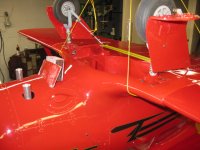You are using an out of date browser. It may not display this or other websites correctly.
You should upgrade or use an alternative browser.
You should upgrade or use an alternative browser.
Yippee! What the postman brought
- Thread starter stangflyer
- Start date
-
- Tags
- 104" skywing extr
Snoopy1
640cc Uber Pimp
Well at last it showed up. 15 pieces of 3/32 light plywood. This should hopefully turn the Edge fuselage back into a plane. That is if I have scaled and drawn up everything correctly, time will tell. The person that did the cutting did a wonderful job clean and good plywood. So that is a good start just have clean everything up and sand the radius’s out in the corners and it will be ready for assembly.


TonyHallo
640cc Uber Pimp
What are you covering? can't waitMy first order arrived today from the new owners at F&M Enterprises.
Awesome service!
They’re clearly carrying on the great tradition.
View attachment 117476
Snoopy1
640cc Uber Pimp
SORRY WRONG LOCATION DO NOT KNOW HOW TO MOVE IT THE WORKSHOP.
Made a start on on the fuselage. Made the four main fuselage spars from spruce and the 4 mm stringers from Sitka spruce running across the bottom. Learnt my lesson long time ago not to put balsa stringers across the bottom of a larger plane.
The first bulkhead is in but not glued, I think I will just fit the second one before the first one is glued in.

Made a start on on the fuselage. Made the four main fuselage spars from spruce and the 4 mm stringers from Sitka spruce running across the bottom. Learnt my lesson long time ago not to put balsa stringers across the bottom of a larger plane.
The first bulkhead is in but not glued, I think I will just fit the second one before the first one is glued in.
Last edited:
WMcNabb
150cc
What are you covering? can't wait
Several projects which have been collecting dust on the shelf. Finally have the big biplane where I want it, so now I can move back to the others.
Below is a photo from too long ago, but I’ll be back on these in the coming days.
WMcNabb
150cc
Is the biplane a Staggerwing?View attachment 117516
That’s the one!
Do you still have yours? Any lessons learned about the airframe or setup you can share?
TonyHallo
640cc Uber Pimp
I got a great deal on the plane, it was new but out of the box, apparently stored in a barn for some time and the box had bird droppings on it. $375 which included the Robart retracts. I had the retracts converted to electric by Robart. I built mine with the functional gear doors, this worked well on asphalt, not so on grass. At a local fun fly I cart wheeled the plane during take off, quite the embarrassment! Shocked the formers loose in the fuselage, I don't think they were glassed in very well from the beginning. There's was very little damage done and repairable. It was just sitting in my basement. I joined a new local club that is a restricted runway and the owner is quite the aviation buff. We were talking one day he had asked what other planes I have, when I mentioned the Staggerwing he got very excited and wanted to buy it to display at his home in the city of Pittsburgh, rather than sell it, I agreed to let him use it for as long as he likes. Apparently he had flown in a Staggerwing painted the same red color. The plane now sits in a plexiglass enclosed display in front of his house in the city, the roof rafters are plywood cutout in wing rib form, there's a half dozen planes inside, 1/3 scale Cub is one, don't remember the others.
Back to your question;
If flying off grass, leave the lower main doors off. There would be grass stuck at the hinge line after every flight.
The included steel wires for the elevator, rudder, and retract are too heavy, I ended up using carbon fiber rods from CST.
The plane was tail heavy so do what can to reduce tail weight. The battery packs had 16" extensions so I could get them as far forward as possible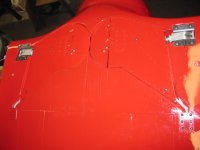
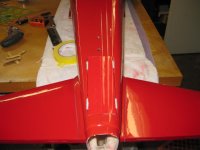
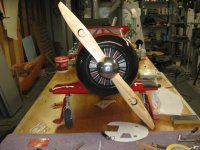
I used a Valley View 40 twin, flew very well.
Back to your question;
If flying off grass, leave the lower main doors off. There would be grass stuck at the hinge line after every flight.
The included steel wires for the elevator, rudder, and retract are too heavy, I ended up using carbon fiber rods from CST.
The plane was tail heavy so do what can to reduce tail weight. The battery packs had 16" extensions so I could get them as far forward as possible



I used a Valley View 40 twin, flew very well.
Last edited:
WMcNabb
150cc
I got a great deal on the plane, it was new but out of the box, apparently stored in a barn for some time and the box had bird droppings on it. $375 which included the Robart retracts. I had the retracts converted to electric by Robart. I built mine with the functional gear doors, this worked well on asphalt, not so on grass. At a local fun fly I cart wheeled the plane during take off, quite the embarrassment! Shocked the formers loose in the fuselage, I don't think they were glassed in very well from the beginning. There's was very little damage done and repairable. It was just sitting in my basement. I joined a new local club that is a restricted runway and the owner is quite the aviation buff. We were talking one day he had asked what other planes I have, when I mentioned the Staggerwing he got very excited and wanted to buy it to display at his home in the city of Pittsburgh, rather than sell it, I agreed to let him use it for as long as he likes. Apparently he had flown in a Staggerwing painted the same red color. The plane now sits in a plexiglass enclosed display in front of his house in the city, the roof rafters are plywood cutout in wing rib form, there's a half dozen planes inside, 1/3 scale Cub is one, don't remember the others.
Back to your question;
If flying off grass, leave the lower main doors off. There would be grass stuck at the hinge line after every flight.
The included steel wires for the elevator, rudder, and retract are too heavy, I ended up using carbon fiber rods from CST.
The plane was tail heavy so do what can to reduce tail weight. The battery packs had 16" extensions so I could get them as far forward as possibleView attachment 117517 View attachment 117518 View attachment 117519
I used a Valley View 40 twin, flew very well.
Some more photos, pretty sure the photo when loaded in the aircraft carrier was the morning of the fun fly with my old reliable RC Guys Cherokee. It's a good thing I took two!
View attachment 117520 View attachment 117521 View attachment 117522
Thank you for the insights. I was thinking hard about making this one electric, but really like the idea of the small twin.
Either way, I’ll make the tail as light as possible.
Interesting that yours is in a display case now! I assembled two of these for displays previously. Neither were ever flown, just hung from the ceiling.
Started with the fabric conversion to replicate a full scale flown by a good friend. However, since the time the wings were stripped, we lost both he and the airplane, so I’m not sure what the final scheme will be. I just know that painting it will be much easier with Stits than trying to match the fiberglass fuse and cowling with monokote or ultracote.

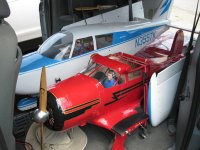
![unnamed[1].jpg unnamed[1].jpg](https://www.giantscalenews.com/data/attachments/117/117573-61f9427c91d78300e4d0aaa0f141113f.jpg)
